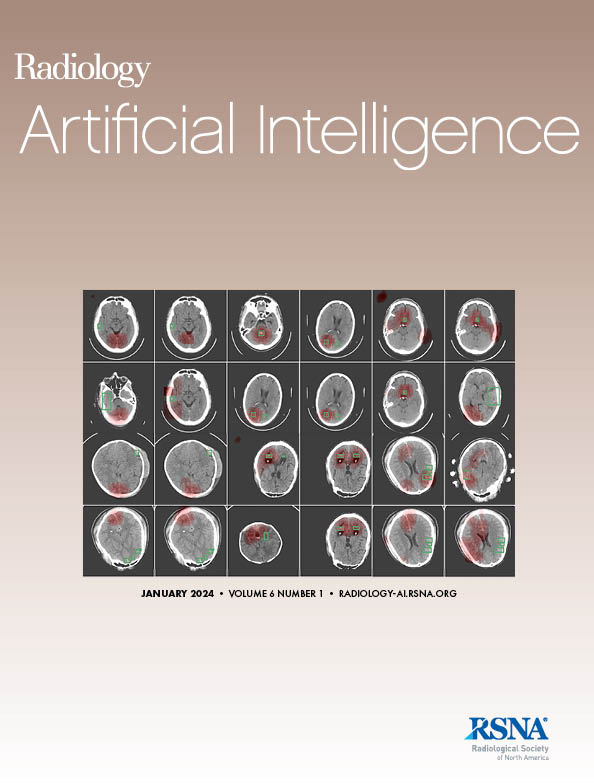Di Zhang, Mingyue Zhao, Xiuxiu Zhou, Yiwei Li, Yu Guan, Yi Xia, Jin Zhang, Qi Dai, Jingfeng Zhang, Li Fan, S Kevin Zhou, Shiyuan Liu
求助PDF
{"title":"基于单吸气胸部ct的生成深度学习模型评估功能性小气道疾病。","authors":"Di Zhang, Mingyue Zhao, Xiuxiu Zhou, Yiwei Li, Yu Guan, Yi Xia, Jin Zhang, Qi Dai, Jingfeng Zhang, Li Fan, S Kevin Zhou, Shiyuan Liu","doi":"10.1148/ryai.240680","DOIUrl":null,"url":null,"abstract":"<p><p>Purpose To develop a deep learning model that uses a single inspiratory chest CT scan to perform parametric response mapping (PRM) and predict functional small airways disease (fSAD). Materials and Methods In this retrospective study, predictive and generative deep learning models for PRM using inspiratory chest CT were developed using a model development dataset with fivefold cross-validation, with PRM derived from paired respiratory CT as the reference standard. Voxelwise metrics, including sensitivity, area under the receiver operating characteristic curve (AUC), and structural similarity index measure, were used to evaluate model performance in predicting PRM and generating expiratory CT images. The best-performing model was tested on three internal test sets and an external test set. Results The model development dataset of 308 individuals (median age, 67 years [IQR: 62-70 years]; 113 female) was divided into the training set (<i>n</i> = 216), the internal validation set (<i>n</i> = 31), and the first internal test set (<i>n</i> = 61). The generative model outperformed the predictive model in detecting fSAD (sensitivity, 86.3% vs 38.9%; AUC, 0.86 vs 0.70). The generative model performed well in the second internal (AUCs of 0.64, 0.84, and 0.97 for emphysema, fSAD, and normal lung tissue, respectively), the third internal (AUCs of 0.63, 0.83, and 0.97), and the external (AUCs of 0.58, 0.85, and 0.94) test sets. Notably, the model exhibited exceptional performance in the preserved ratio impaired spirometry group of the fourth internal test set (AUCs of 0.62, 0.88, and 0.96). Conclusion The proposed generative model, using a single inspiratory CT scan, outperformed existing algorithms in PRM evaluation and achieved comparable results to paired respiratory CT. <b>Keywords:</b> CT, Lung, Chronic Obstructive Pulmonary Disease, Diagnosis, Reconstruction Algorithms, Deep Learning, Parametric Response Mapping, X-ray Computed Tomography, Small Airways <i>Supplemental material is available for this article.</i> © The Author(s) 2025. Published by the Radiological Society of North America under a CC BY 4.0 license. See also the commentary by Hathaway and Singh in this issue.</p>","PeriodicalId":29787,"journal":{"name":"Radiology-Artificial Intelligence","volume":" ","pages":"e240680"},"PeriodicalIF":13.2000,"publicationDate":"2025-09-01","publicationTypes":"Journal Article","fieldsOfStudy":null,"isOpenAccess":false,"openAccessPdf":"","citationCount":"0","resultStr":"{\"title\":\"Single Inspiratory Chest CT-based Generative Deep Learning Models to Evaluate Functional Small Airways Disease.\",\"authors\":\"Di Zhang, Mingyue Zhao, Xiuxiu Zhou, Yiwei Li, Yu Guan, Yi Xia, Jin Zhang, Qi Dai, Jingfeng Zhang, Li Fan, S Kevin Zhou, Shiyuan Liu\",\"doi\":\"10.1148/ryai.240680\",\"DOIUrl\":null,\"url\":null,\"abstract\":\"<p><p>Purpose To develop a deep learning model that uses a single inspiratory chest CT scan to perform parametric response mapping (PRM) and predict functional small airways disease (fSAD). Materials and Methods In this retrospective study, predictive and generative deep learning models for PRM using inspiratory chest CT were developed using a model development dataset with fivefold cross-validation, with PRM derived from paired respiratory CT as the reference standard. Voxelwise metrics, including sensitivity, area under the receiver operating characteristic curve (AUC), and structural similarity index measure, were used to evaluate model performance in predicting PRM and generating expiratory CT images. The best-performing model was tested on three internal test sets and an external test set. Results The model development dataset of 308 individuals (median age, 67 years [IQR: 62-70 years]; 113 female) was divided into the training set (<i>n</i> = 216), the internal validation set (<i>n</i> = 31), and the first internal test set (<i>n</i> = 61). The generative model outperformed the predictive model in detecting fSAD (sensitivity, 86.3% vs 38.9%; AUC, 0.86 vs 0.70). The generative model performed well in the second internal (AUCs of 0.64, 0.84, and 0.97 for emphysema, fSAD, and normal lung tissue, respectively), the third internal (AUCs of 0.63, 0.83, and 0.97), and the external (AUCs of 0.58, 0.85, and 0.94) test sets. Notably, the model exhibited exceptional performance in the preserved ratio impaired spirometry group of the fourth internal test set (AUCs of 0.62, 0.88, and 0.96). Conclusion The proposed generative model, using a single inspiratory CT scan, outperformed existing algorithms in PRM evaluation and achieved comparable results to paired respiratory CT. <b>Keywords:</b> CT, Lung, Chronic Obstructive Pulmonary Disease, Diagnosis, Reconstruction Algorithms, Deep Learning, Parametric Response Mapping, X-ray Computed Tomography, Small Airways <i>Supplemental material is available for this article.</i> © The Author(s) 2025. Published by the Radiological Society of North America under a CC BY 4.0 license. See also the commentary by Hathaway and Singh in this issue.</p>\",\"PeriodicalId\":29787,\"journal\":{\"name\":\"Radiology-Artificial Intelligence\",\"volume\":\" \",\"pages\":\"e240680\"},\"PeriodicalIF\":13.2000,\"publicationDate\":\"2025-09-01\",\"publicationTypes\":\"Journal Article\",\"fieldsOfStudy\":null,\"isOpenAccess\":false,\"openAccessPdf\":\"\",\"citationCount\":\"0\",\"resultStr\":null,\"platform\":\"Semanticscholar\",\"paperid\":null,\"PeriodicalName\":\"Radiology-Artificial Intelligence\",\"FirstCategoryId\":\"1085\",\"ListUrlMain\":\"https://doi.org/10.1148/ryai.240680\",\"RegionNum\":0,\"RegionCategory\":null,\"ArticlePicture\":[],\"TitleCN\":null,\"AbstractTextCN\":null,\"PMCID\":null,\"EPubDate\":\"\",\"PubModel\":\"\",\"JCR\":\"Q1\",\"JCRName\":\"COMPUTER SCIENCE, ARTIFICIAL INTELLIGENCE\",\"Score\":null,\"Total\":0}","platform":"Semanticscholar","paperid":null,"PeriodicalName":"Radiology-Artificial Intelligence","FirstCategoryId":"1085","ListUrlMain":"https://doi.org/10.1148/ryai.240680","RegionNum":0,"RegionCategory":null,"ArticlePicture":[],"TitleCN":null,"AbstractTextCN":null,"PMCID":null,"EPubDate":"","PubModel":"","JCR":"Q1","JCRName":"COMPUTER SCIENCE, ARTIFICIAL INTELLIGENCE","Score":null,"Total":0}
引用次数: 0
引用
批量引用

 求助内容:
求助内容: 应助结果提醒方式:
应助结果提醒方式:


